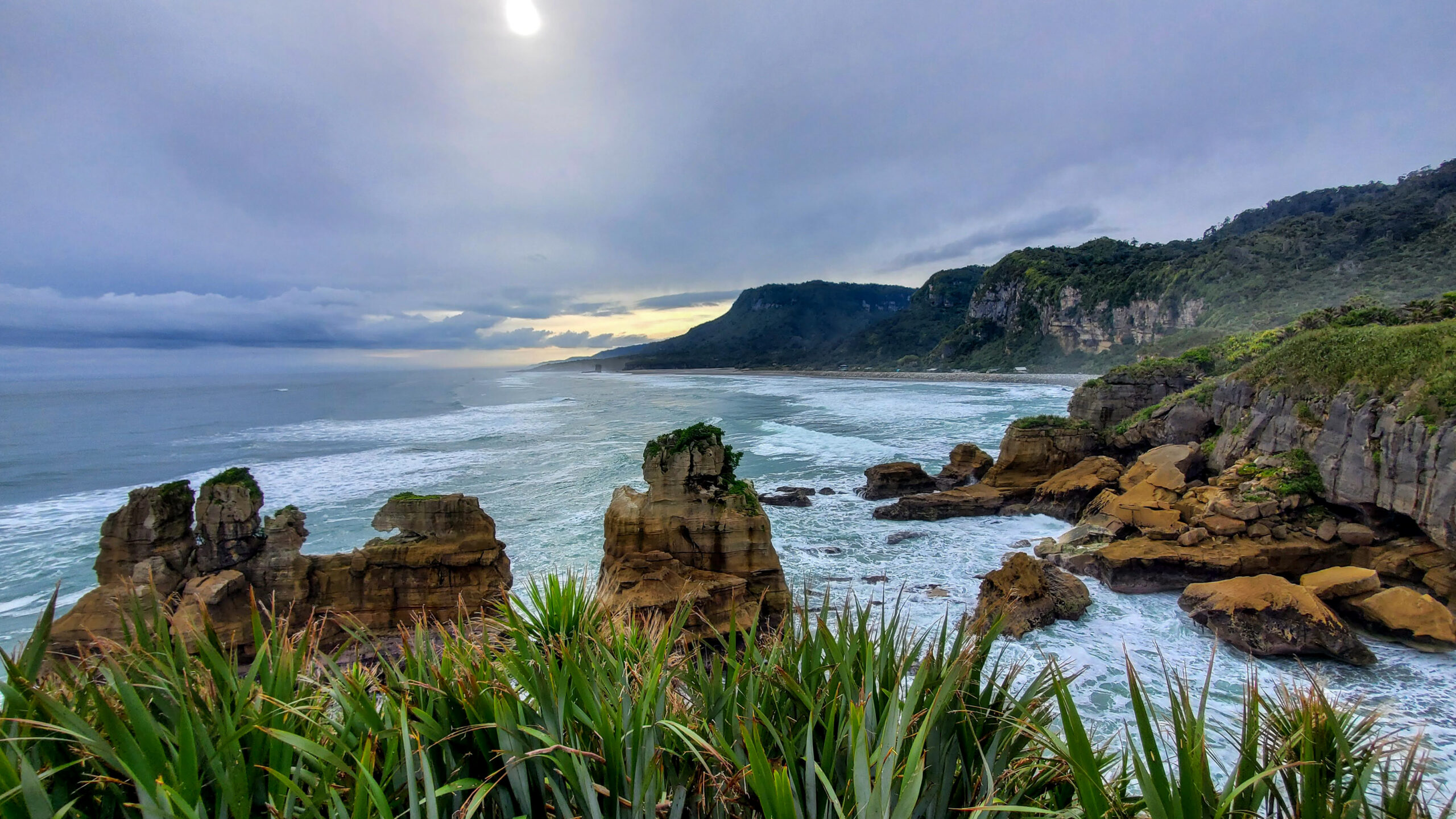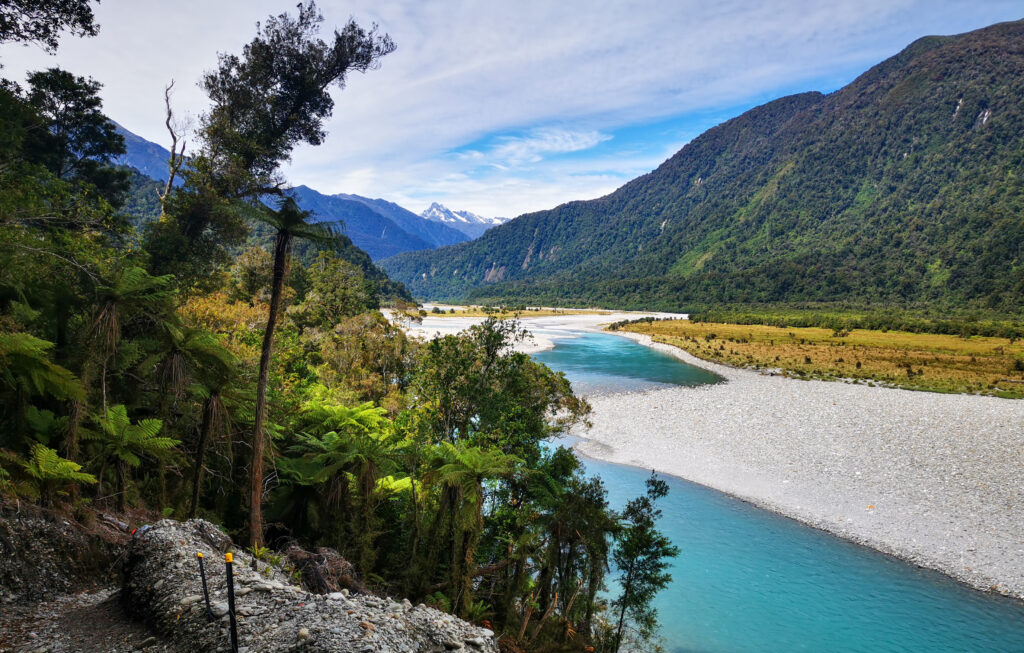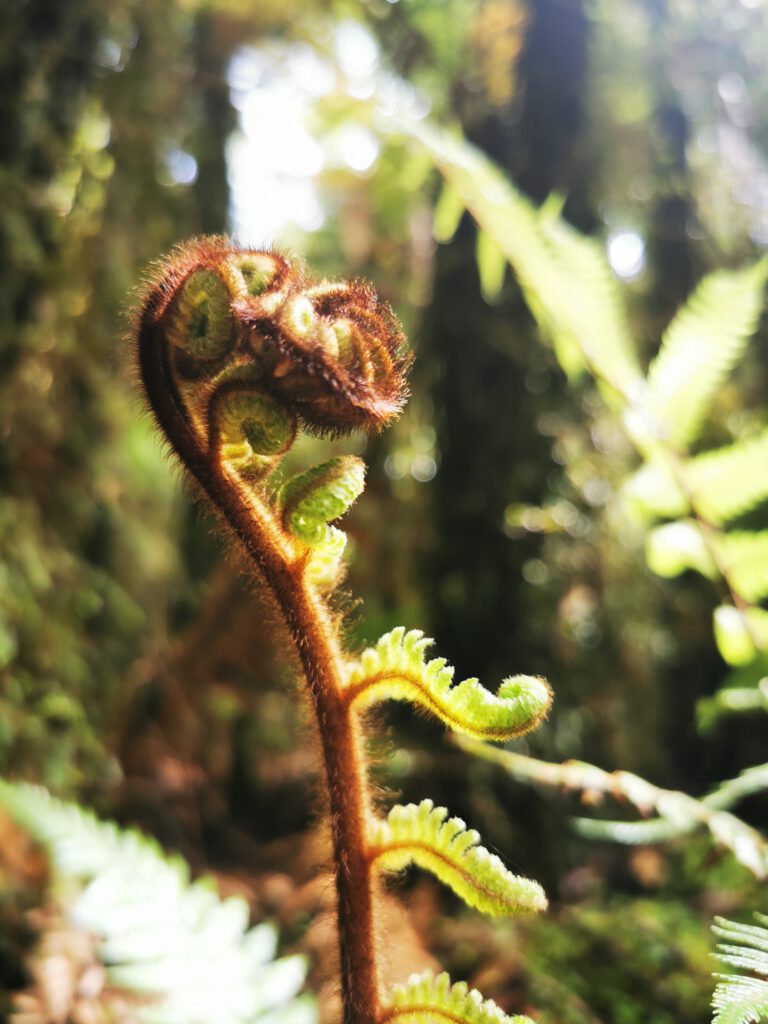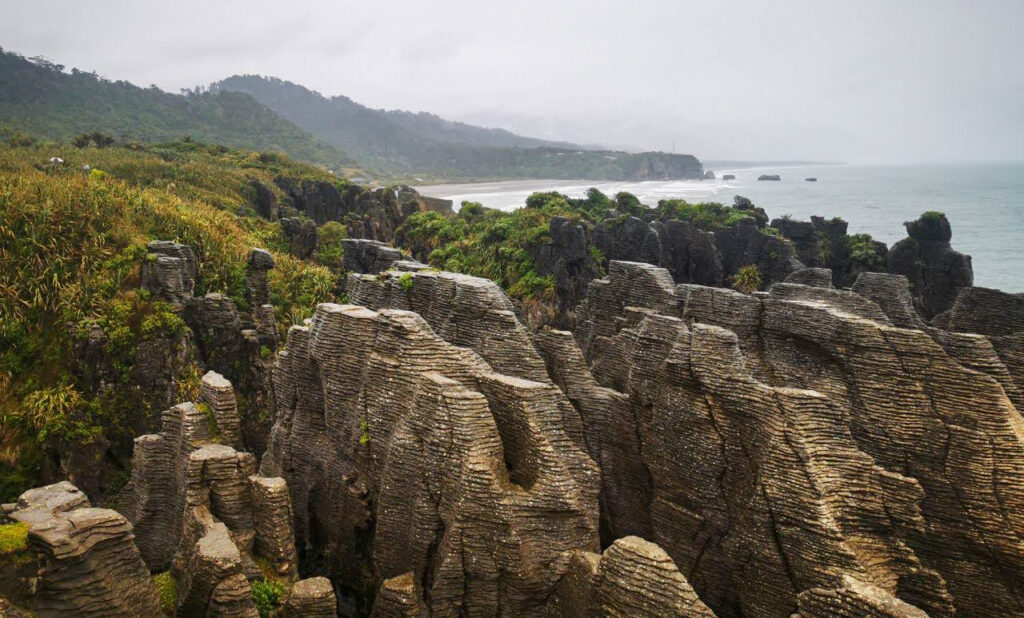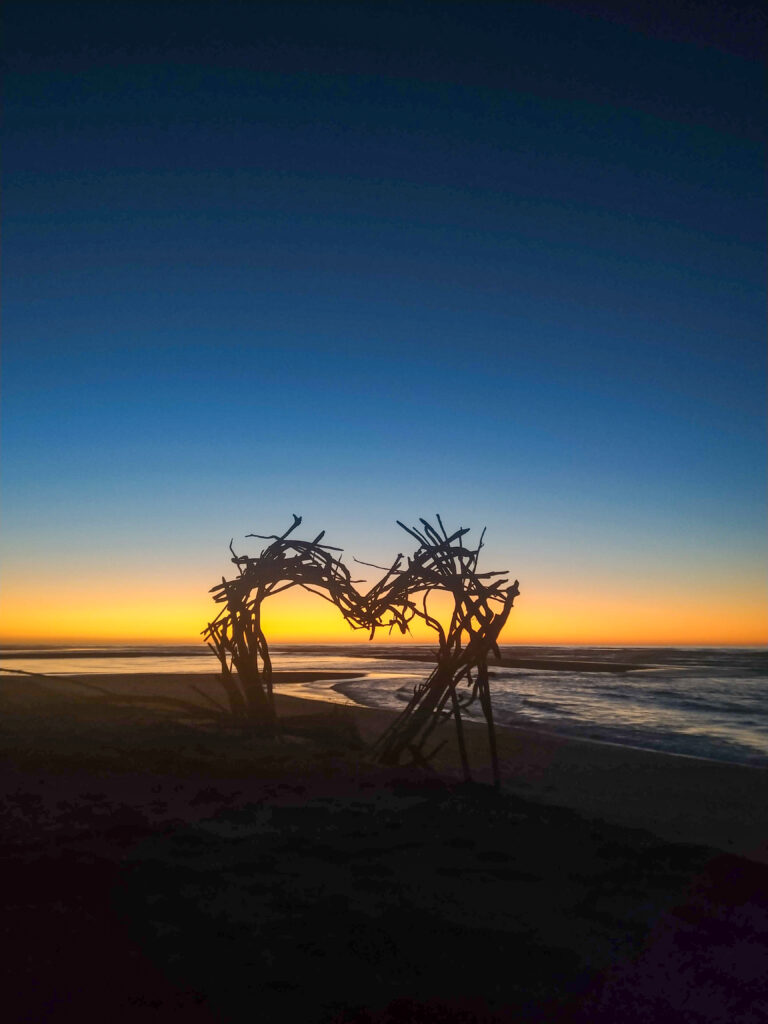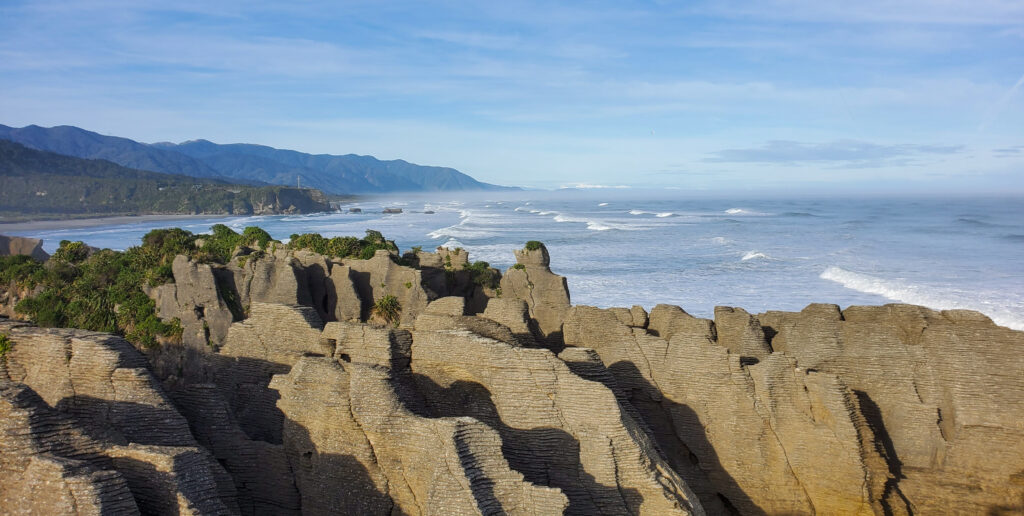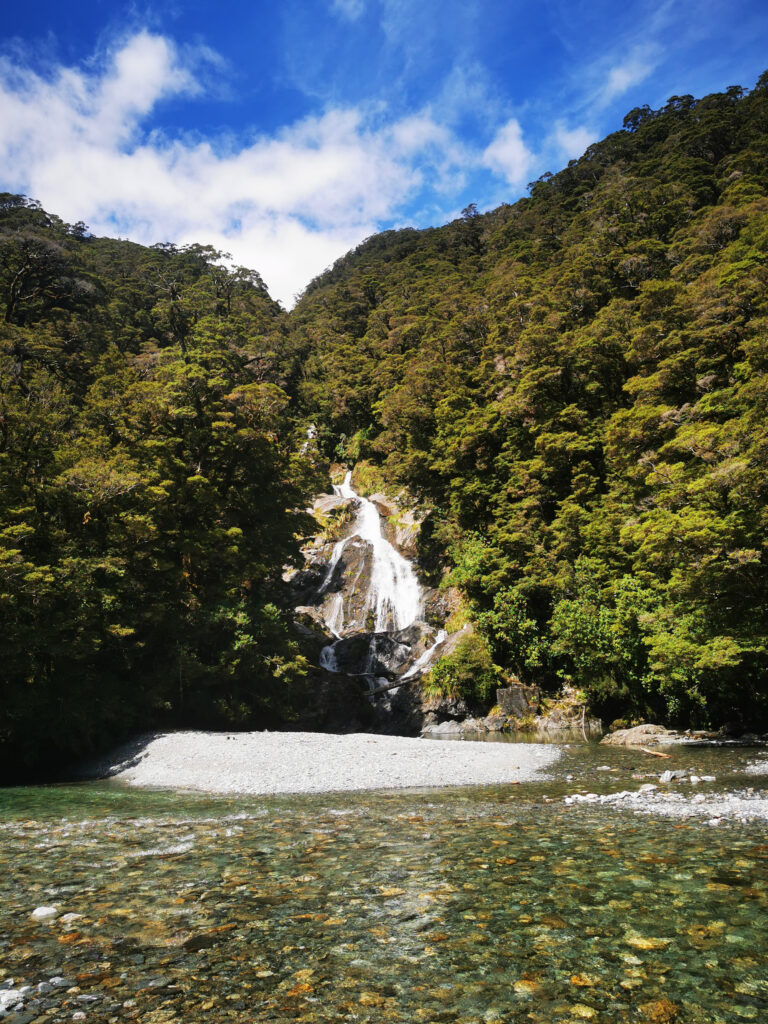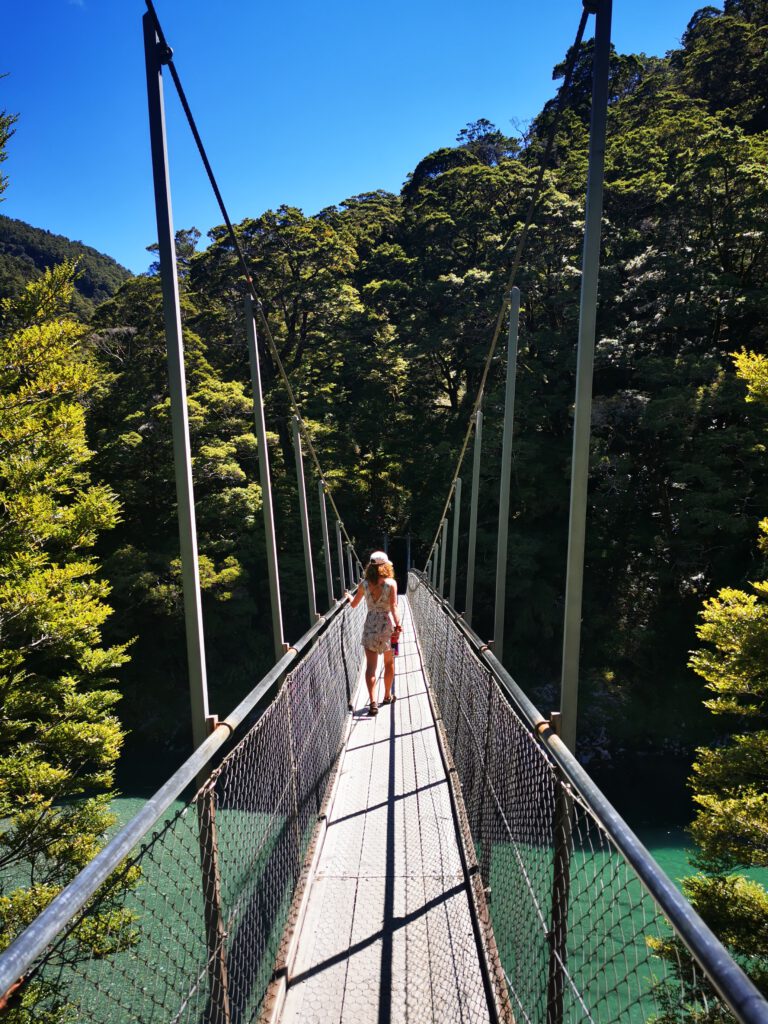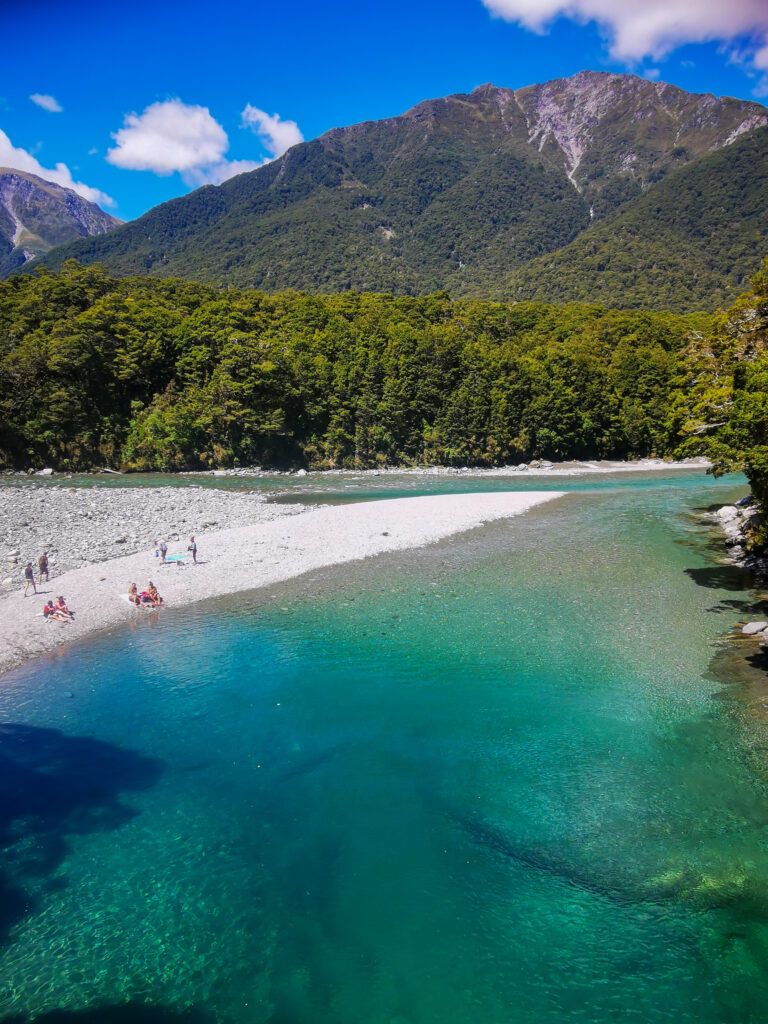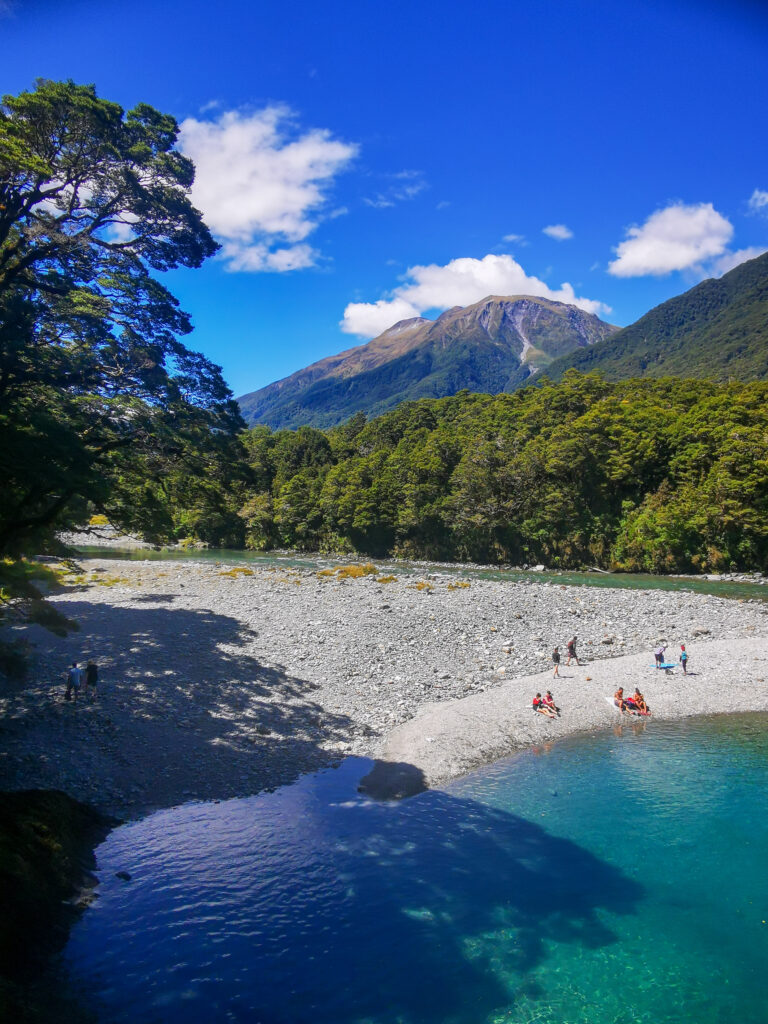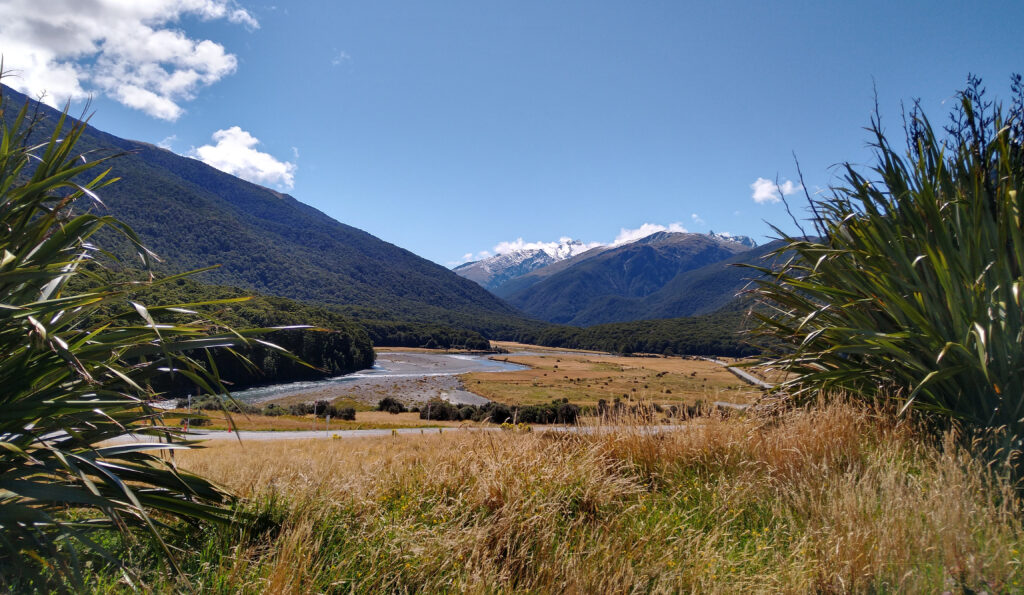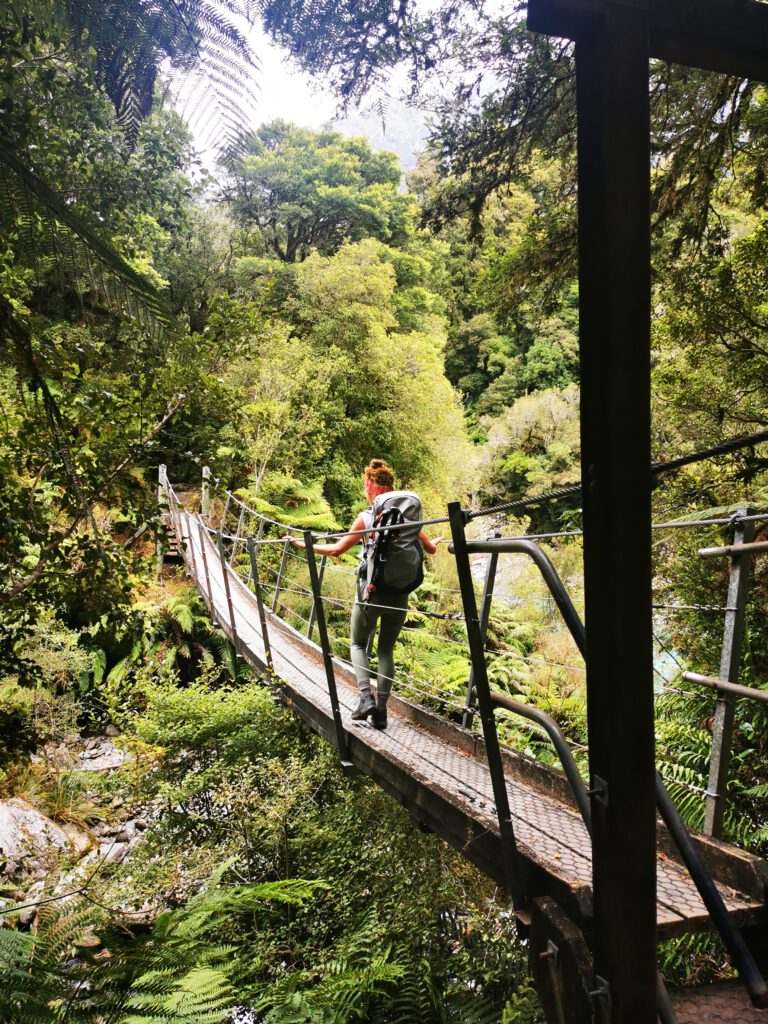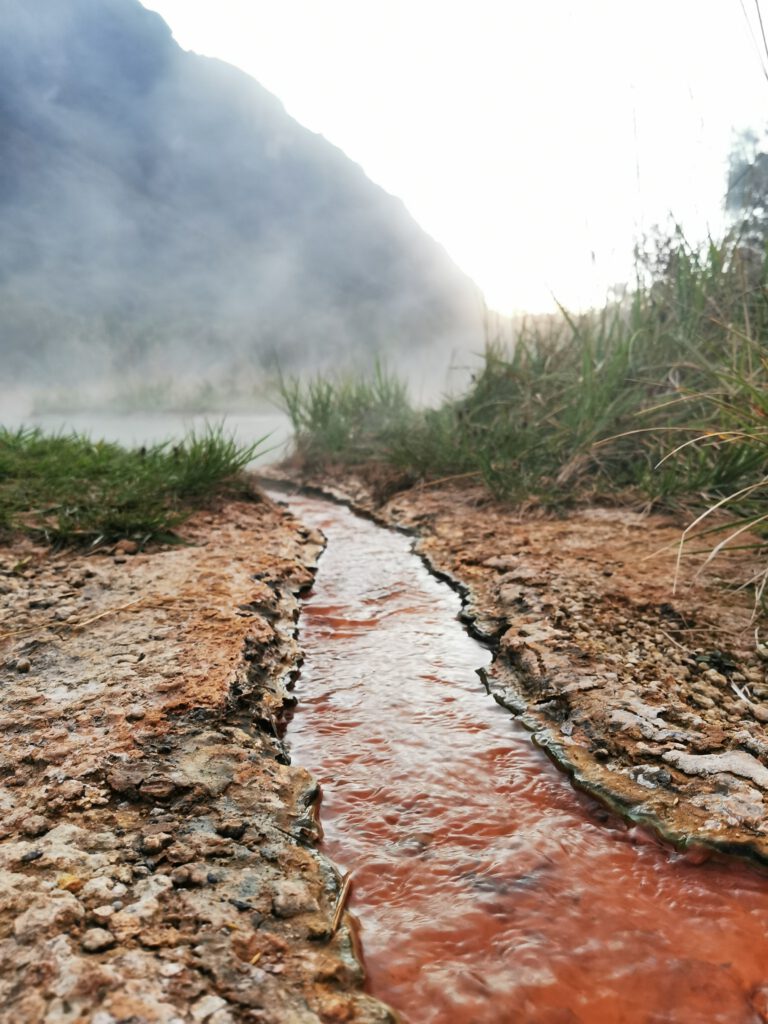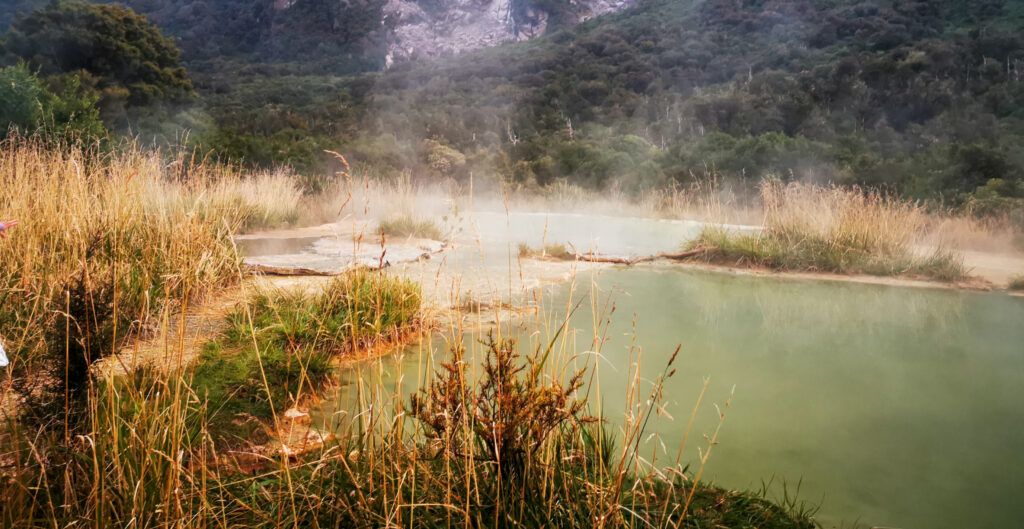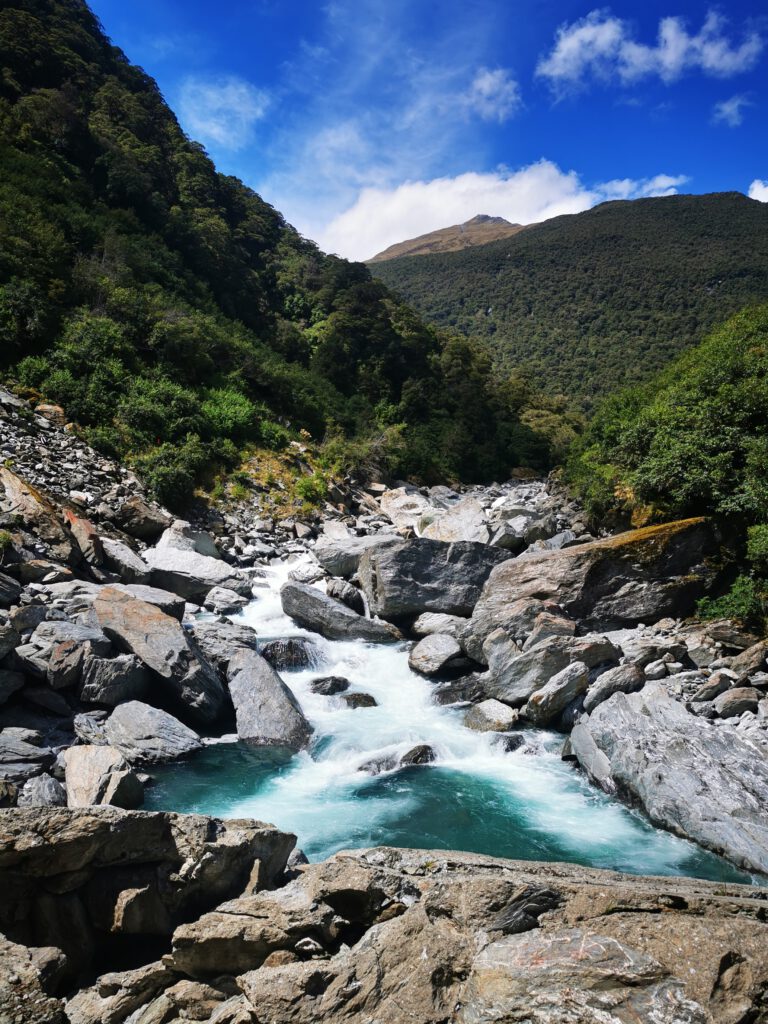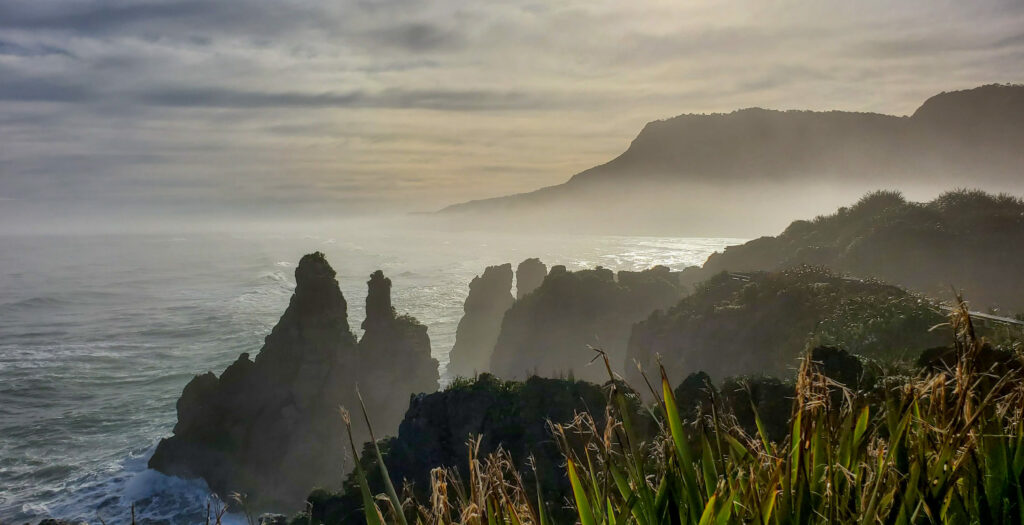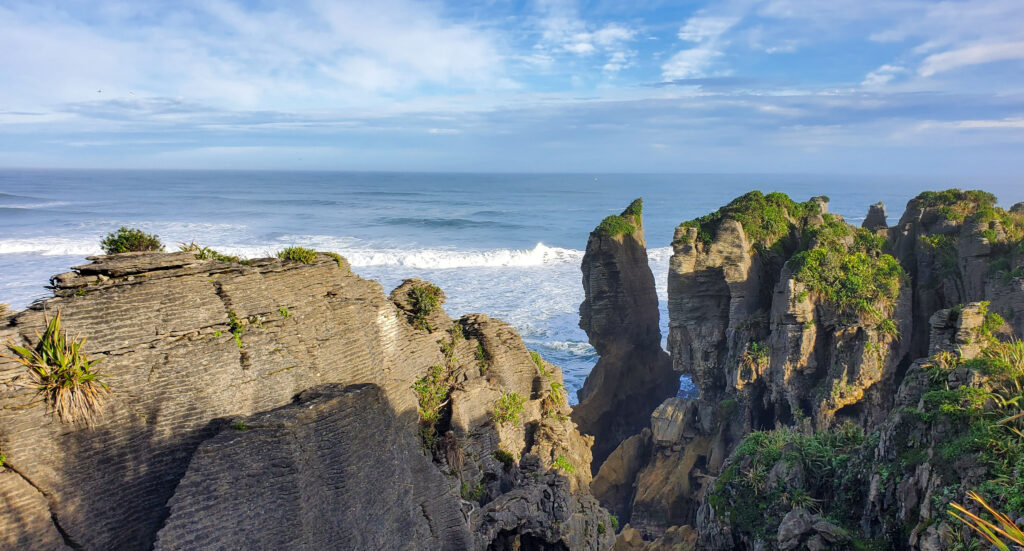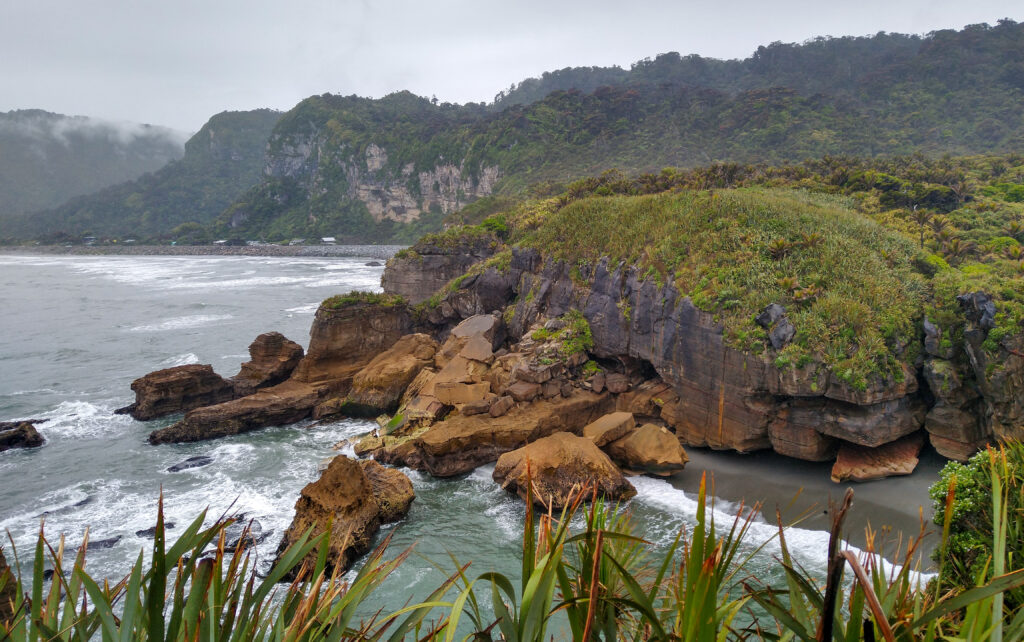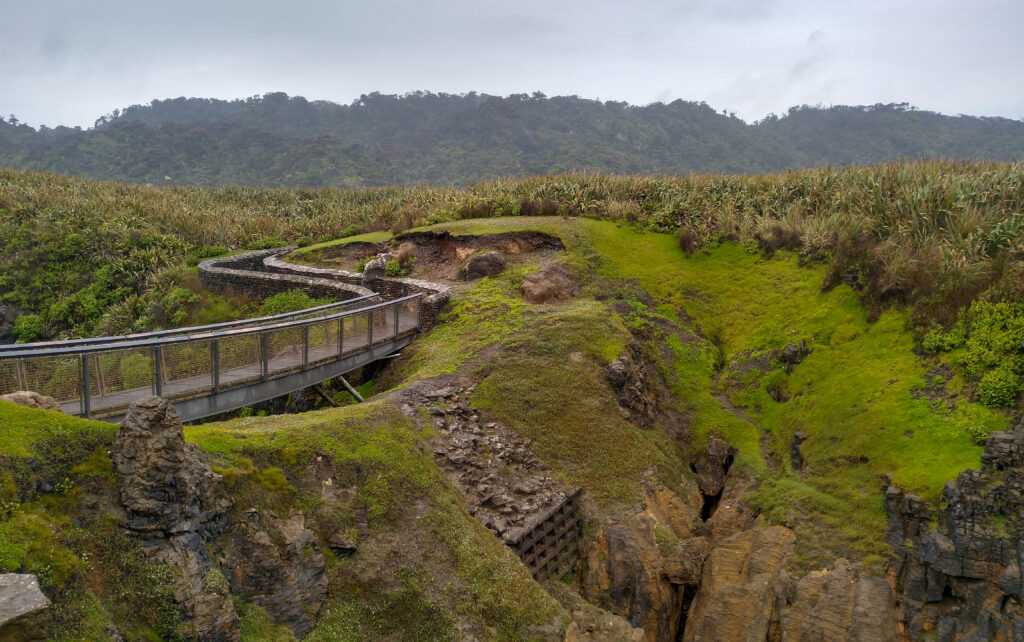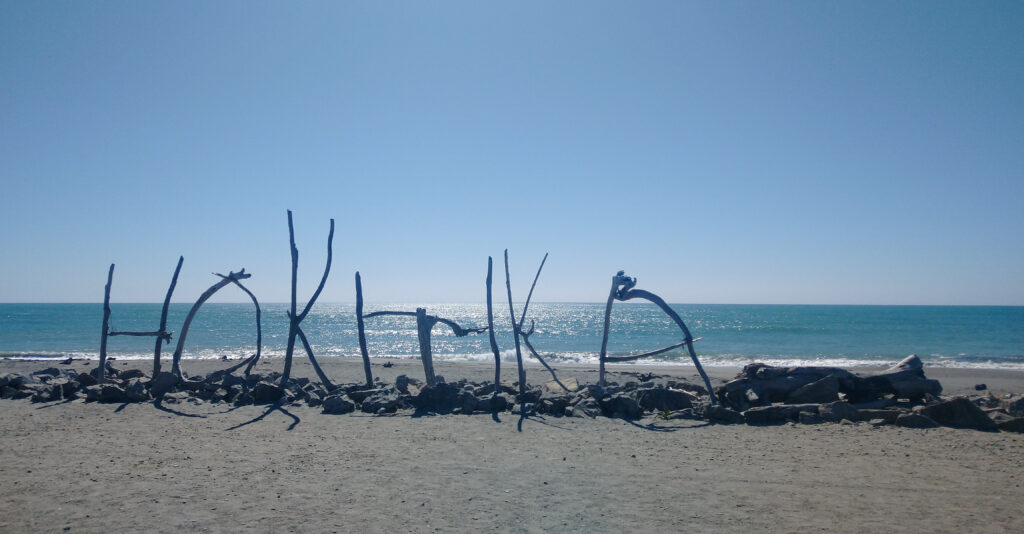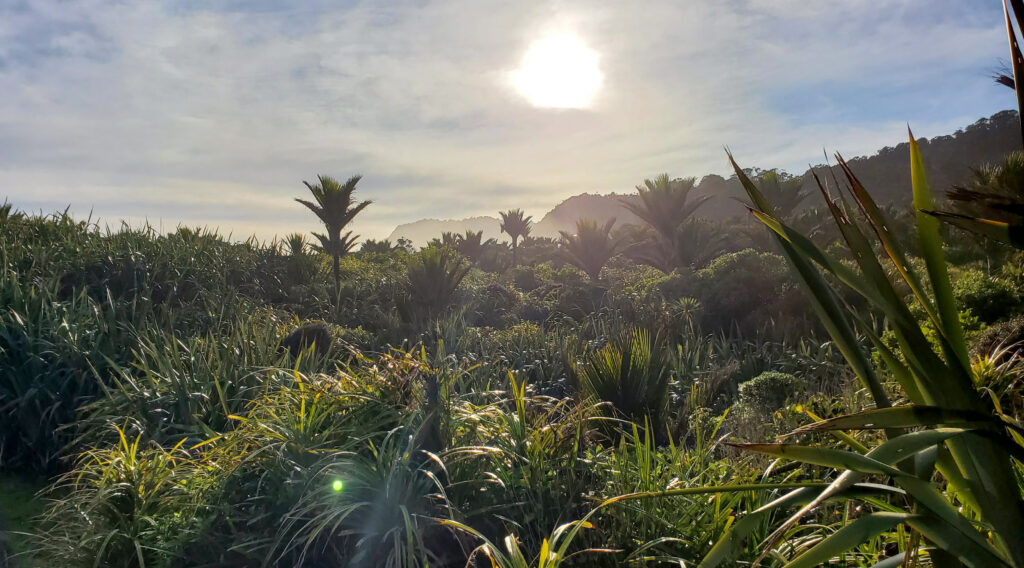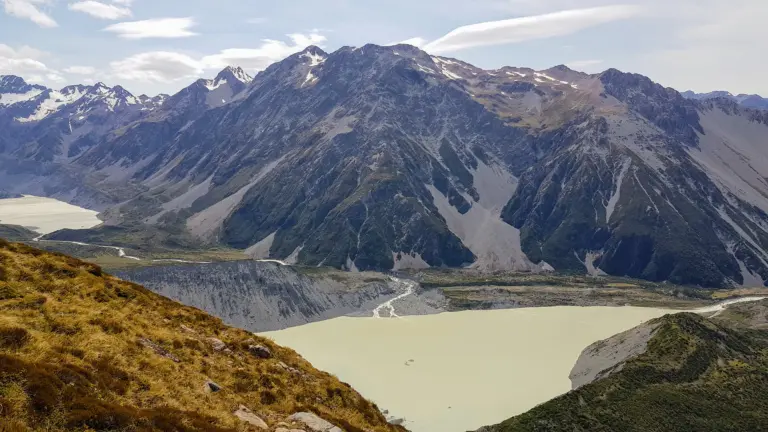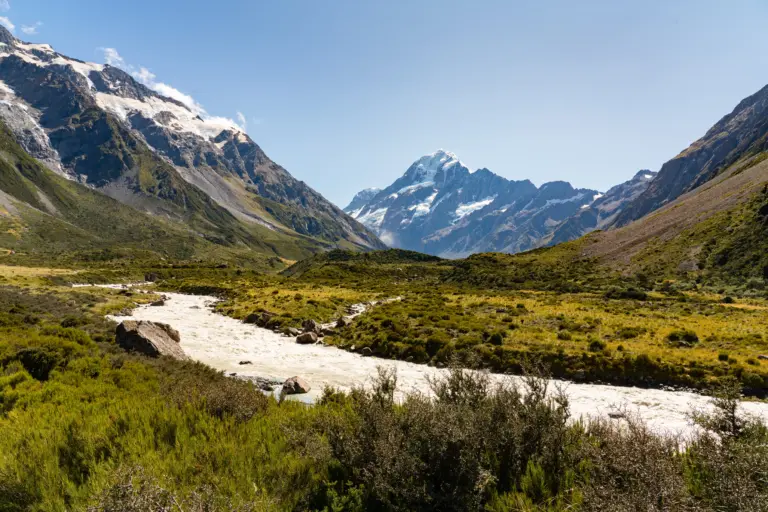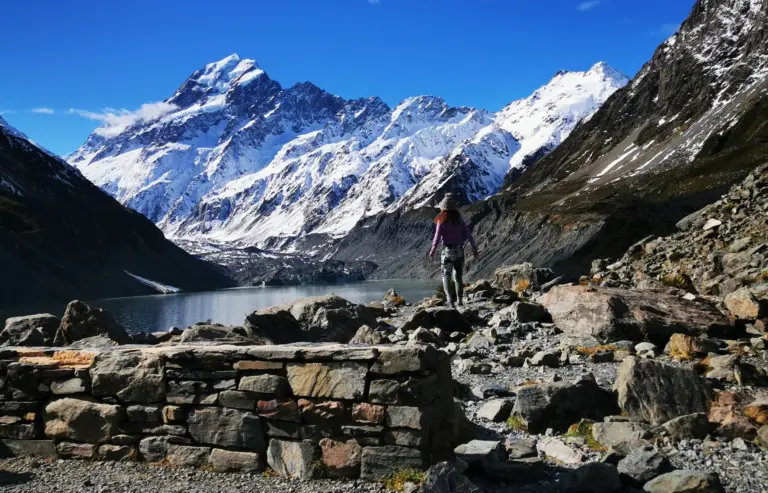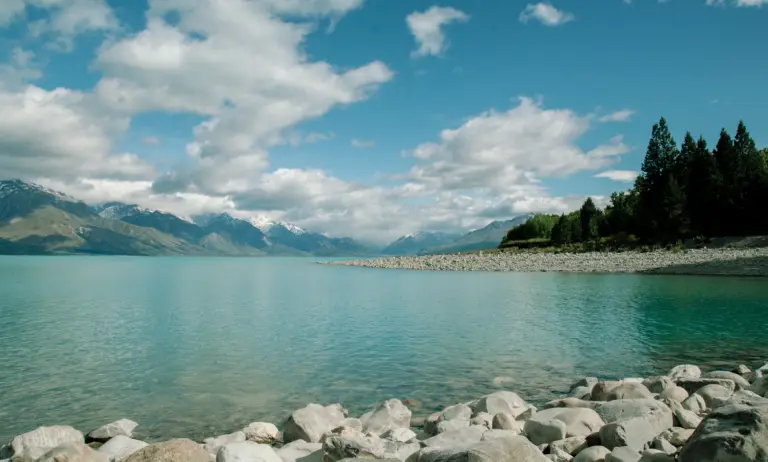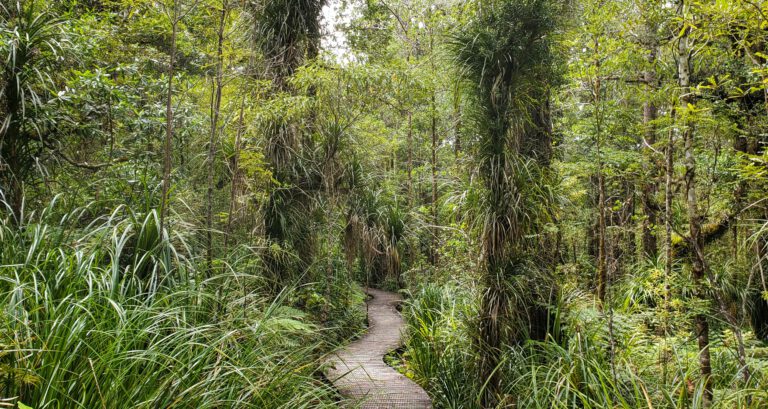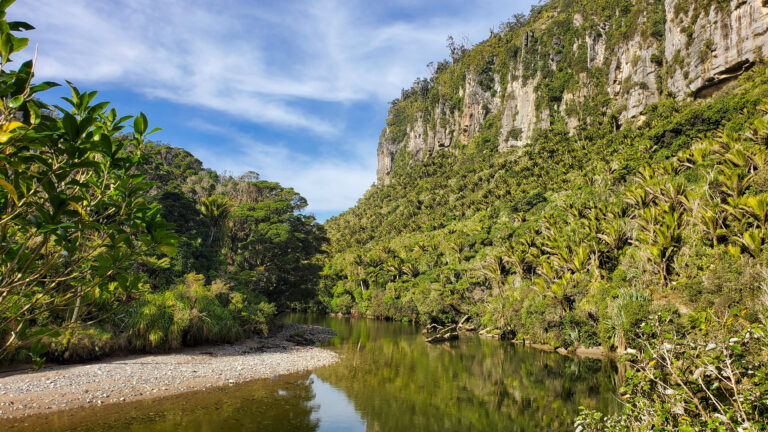A Travel Guide to the West Coast of New Zealand
Last Updated: 15th August, 2023
Travelling to the West Coast of New Zealand is like taking a step back into the wild, untamed past! Spanning from Mount Aspiring National Park in the south, to Kahurangi National Park in the north, the West Coast is filled with lush rainforest, rugged coastline, dramatic glaciers and charming towns – any traveller’s dream!
We spent two weeks travelling along the length of the West Coast in our trusty campervan, and loved the seclusion and untouched feeling that it has. In this post I will mention some of our favourite places to visit while on the West Coast, including awesome hikes, cool campgrounds, and old, historic towns!
What is the best time of year to visit the West Coast?
When planning your trip to the West Coast, it’s essential to consider the best time to visit. The region experiences an oceanic climate, being nestled between the Tasman Sea and the Southern Alps, and is known for its mild summers and cool winters. The weather throughout the West Coast is dramatic and therefore can be pretty exciting – when it rains, it pours and when it’s sunny, it’s gorgeous! It rains more here than in any other region of New Zealand, so make sure to bring your wet weather gear. Spring is generally the wettest time of the year on the West Coast, and creates the lush palms and rainforest the West Coast is famous for!
The best time to visit the West Coast of New Zealand is in late summer, from January to March, which have the highest average temperatures and the least amount of rain (bonus!). The temperature in summer is mild, and ranges from around 12-25℃, making this the perfect time for outdoor activities!
The West Coast is also an awesome place to visit in the winter months, from June to August. Although cold, with temperatures averaging around 5-15℃, these months are often characterised with weeks of perfect sunshine – with a backdrop of snowy mountains! During winter, the West Coast is often warmer than the nearby cities of Christchurch and Queenstown.
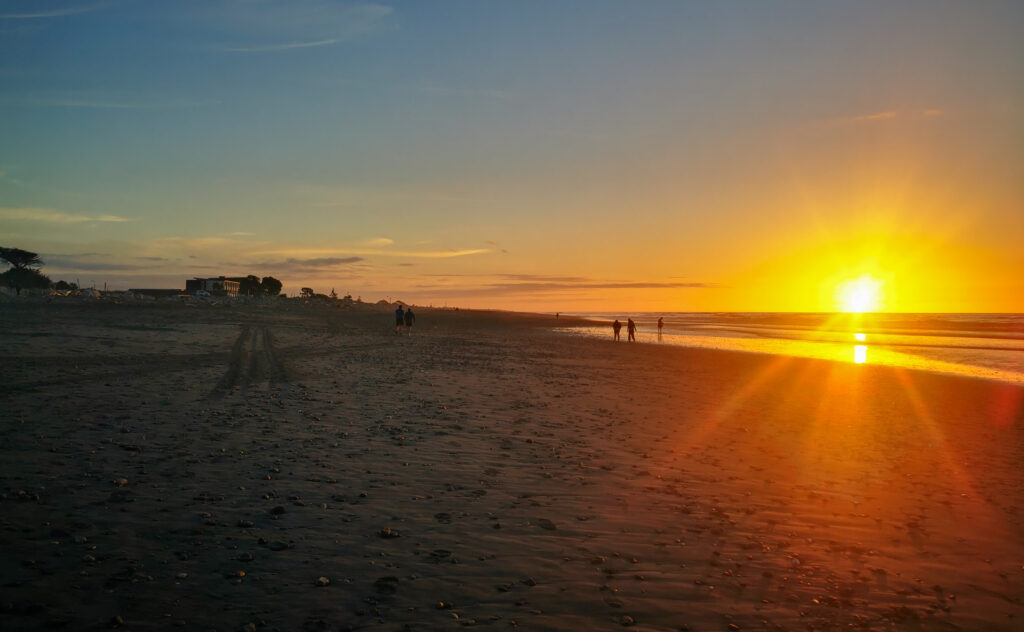
How to get to the West Coast!
Driving
Driving is a popular option for reaching the West Coast. State Highway 6, also known as the Coastal Pacific Highway, is the main route that runs along the coast. You can access it from major cities like Christchurch or Queenstown and enjoy a scenic drive with breathtaking coastal and mountain views.
Public Transport
Another convenient way to reach the West Coast is by bus. There are bus services that operate between the West Coast and various cities in New Zealand. Intercity and other bus companies offer regular services, providing a comfortable and affordable option for travellers.
Train
The TranzAlpine train service is a popular scenic rail journey that connects Christchurch on the East Coast to Greymouth on the West Coast. This iconic train ride takes you through the breathtaking Southern Alps, offering stunning views of mountains, gorges, and river valleys.
Best things to do on the West Coast of New Zealand
The West Coast of New Zealand is filled with sights and activities for any type of adventurer! From awesome hikes into lush rainforest or up dramatic glaciers, to old towns filled with art and history, there is a little something for everyone! Here I have mentioned some of our must-visit places while travelling the West Coast of New Zealand:
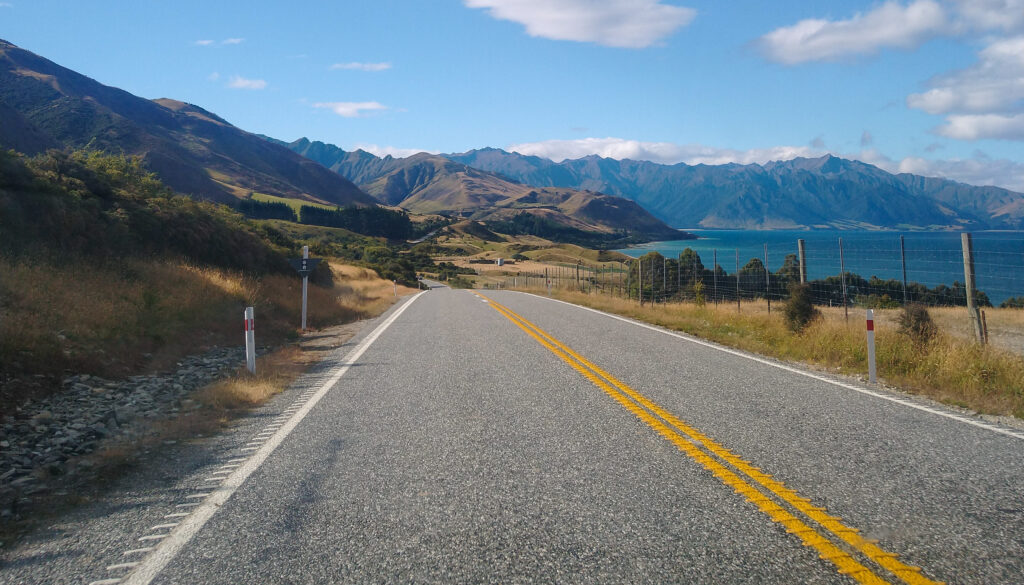
Haast Pass
Haast Pass is, in my humble opinion, one of the most beautiful and scenic drives that New Zealand has to offer! It travels 140km through the Te Wāhipounamu World Heritage Area, stretching from the sunny shores of Lake Wanaka to the small coastal town of Haast, by the wild Tasman Sea. Along the route, you will pass the gorgeous Lakes Wanaka and Hāwea, before winding through the rainforest covered-mountains of the Southern Alps. This drive takes around 2 hours, and it is very windy, however if you have the time it is an incredible journey!
Along the Haast Pass route there are a number of awesome view-points and small walks to do if you have the time. Many of these include viewing magnificent waterfalls, and so of course I had to stop at them all! To read more on driving through the Haast Pass (including where to stay), check out my post here!
Places to See on the Haast Pass:
1. Blue Pools
The Blue Pools is a must-see spot when travelling down the Haast Pass! They are incredibly beautiful (and perfect for that insta-shot!) with crystal-clear, turquoise water, surrounded by lush rainforest. The pools derive their name from the remarkable blue hue of the water, which is a result of the purity and the light reflecting off fine particles of glacier-ground rock suspended in the water. The clarity of the water allows you to see right to the bottom, giving the illusion of incredible depth.
Getting there:
To reach the Blue Pools, there is a short walk from the Haast Pass-Makarora Road. The walk is relatively easy and takes around 15 minutes through a serene beech forest, crossing a suspension bridge over the Makarora River. There is heaps of parking and it is well-signposted, so you are sure not to miss this while driving the Haast Pass!
2. Fantail Falls
The Fantail Falls walk is an easy walk through scenic rainforest, ending in a viewpoint of the beautiful waterfall! This short walk begins from a carpark just 11 minutes drive from the Blue Pools, and will take you around 5 minutes to reach the falls.
3. Thunder Creek Falls
Just a few minutes drive north from Fantail Falls are the spectacular Thunder Creek Falls! The walk takes you through kāmahi and silver beech forest to a viewing platform above the Haast River, where you can see the incredible 28-metre Thunder Creek Falls.
The walk is just 250m-return along an excellent pathway, and takes a couple of minutes each way.
3. Roaring Billy Falls
If you haven’t had your fill of waterfalls yet, another 18 minutes drive (22km) along the Haast Pass will take you past the Roaring Billy Falls. This gentle walk takes you through a beautiful podocarp and silver beech forest, before arriving at the riverbank, where there are great views of the falls! The walk is around 1k return, and will take around 20 minutes. Good news, this path is a boardwalk, and so is buggy and wheelchair friendly!
Hike the Copland Track to Welcome Hut Flat
Out of all the walks that Timo and I have done in New Zealand, the Copland Track is one of my all-time favourites! This is an overnight hike that travels up the gorgeous Karangarua Valley along the banks of the river, before heading on a steep climb up until you reach Welcome Flat Hut. This walk is gorgeous, with lush rainforest, crystal clear water, and enough of a challenge that you can feel completely satisfied once you have reached the top! And have I mentioned… the best reward for reaching the top is not the glorious views over the mountains (although they are stunning), but the natural hot pools that are found just next to the hut! Talk about a way to relax after a long day of hiking!
Track Length: 18 km one-way
Walking Time: Approximately 7-hours one way
Track type: Intermediate grade, as it has some strenuous steep sections and a lot of boulder-hopping along the way!
To read my post on the Copland hike, including how we found the trail and other cool information, check out my post here! 🙂
Fox and Franz Josef Glaciers
Two of the most popular and incredible destinations along the West Coast are the Fox and Franz Josef glaciers, two iconic natural wonders nestled on the rugged coastline. These majestic glaciers, named after the nearby towns of Fox Glacier and Franz Josef Glacier, offer an awe-inspiring spectacle of icy grandeur. These glaciers are among the few in the world that descend so close to sea level, making them easily accessible for exploration.
Guided tours are available for travellers who would love to see the glaciers up close and personal. Equipped with crampons, experienced guides take visitors onto the icy terrain, where they can experience the surreal landscape of pristine blue ice formations, deep crevasses, and sparkling ice caves. For those seeking a more aerial perspective, helicopter tours provide an exhilarating adventure. They soar above the glaciers and allow tourists to witness their breathtaking scale as they stretch across the rugged landscape.
If you are on a tight budget, there are also short walks that allow you amazing views of each glacier!
Fox Glacier South Side Walk
This walkway begins at the Fox River carpark, located 2km south of the Fox Glacier township. The path meanders up along the south bank of the Fox River through ancient podocarp rainforest, before reaching an incredible view point of Fox Glacier Te Moeka o Tuawe!
The walk is 6.4km return, and will take you around an hour to reach the final glacier viewpoint. The path is relatively flat and well-maintained, making this an awesome walk for families! To check out more information on the walk, including track opening and weather conditions, click here!
Franz Josef Glacier Walk
This walk is a 5.4 km walk that begins with a winding path through beautiful podocarp forest, with stunning glimpses of snowy mountains, waterfalls, and the upper glacier. The track then emerges onto the rocky riverbed of the Franz Josef Glacier Valley, where the track becomes a scramble across the uneven stones – so make sure you are wearing some good hiking shoes! Once you reach the end point, however, the magnificent views of the icy giant and the surrounding valley are worth the effort!
Check out if the walk is open, and other related information here!
Getting there:
Drive south from the Franz Josef Waiau township across the Waiho River bridge, and turn left onto the Glacier Access Road. From here, travel 4km up the road until you reach the carpark, which is the starting point for this walk.
It’s essential to note that the Fox and Franz Josef glaciers are dynamic and constantly shifting. Weather conditions and safety considerations can affect access to certain areas, so it’s recommended to check with local authorities or tour operators for the latest updates before planning your visit.
Hokitika Gorge
Only 30 minutes from the coastal town of Hokitika is the beautiful Hokitika Gorge, a hidden-gem tucked away in the pristine wilderness of the West Coast. From the carpark, there is a 15-minute walk down a well-maintained track that winds its way through lush native bush, until you reach the gorge. The gorge is stunning, with vibrant blue water and surrounding greenery creating a striking contrast! Don’t forget your camera!
Getting there:
To reach this natural wonder, embark on a scenic drive from Hokitika town, following Kaniere Kowhitirangi Rd for approximately 33 kilometers (30 minutes). This is a popular tourist spot, and so there is fantastic signage along the road.
Shantytown Heritage Park
If you fancy a dive back in time to the wild gold-rush era of the West Coast, a visit to Shantytown Heritage Park is for you! This is a captivating open-air museum that showcases the rich history of New Zealand’s gold rush era, complete with meticulously recreated buildings and streets that transport you to the 19th century! Here, you can learn about the treacherous lives of gold-miners that lived in the region, with interactive displays, live demonstrations, and engaging exhibits. You can even have a chance to pan for your own gold!
Getting there:
Shantytown is located just outside of Greymouth, with a short 10-minute drive south down SH6 taking you to the museum.
Punakaiki Rocks
As you head further up the West Coast of New Zealand, you have to make a stop at the incredible ‘Pancake Rocks’ in Punakaiki! As the name suggests, these are incredible rock formations that look remarkably like a stack of pancakes (yum!) and are located within the Punakaiki Rocks Reserve, close to the small township of Punakaiki. There is a walking track that winds its way around the headland, offering you stunning views of the unique limestone formations that have been sculpted by millions of years of erosion and seismic activity. The 20-minute loop walk takes you through native forest and reveals panoramic vistas of the Tasman Sea. If you’re lucky, you can stop and watch the water surge up through natural blowholes, shooting water high into the air. This definitely makes for an exciting walk!
There is heaps to see and do around Punakaiki, and it’s worth stopping and exploring the area for a few days if you have the time! To see my complete list of Things to Do in and around Punakaiki, check out my post here! And if you are hunting for accommodation close by, don’t worry – I have you covered!
Towns along the West Coast of New Zealand
The West Coast of New Zealand is dotted with charming towns that embody the region’s unique character and rich history. From bustling coastal hubs to quaint settlements nestled amidst stunning natural landscapes, each town offers its own distinct allure. Here are some of the main towns you’ll encounter while exploring the West Coast:
Greymouth
Located at the mouth of the Grey River, Greymouth is the largest town on the West Coast. It serves as a gateway to the region and offers a range of amenities, including accommodation, dining, and shopping options. Greymouth was one of the main gold-mining towns on the West Coast in the 1860’s, and there is heaps of incredible history to explore at the Shantytown Heritage Park.
Hokitika
Known for its artistic flair and stunning sunsets, Hokitika is a vibrant town that is filled with its creativity and charm. Here, you can discover the art of pounamu (greenstone) carving at local galleries, where skilled artisans transform raw stone into intricate jewellery and sculptures. One of my favourite things to do in Hokitika is to take a stroll along the beach and see the awesome driftwood art, or to drive inland and explore the magnificent Hokitika Gorge! Bonus: If you time your trip correctly, you could experience the excitement of the annual Hokitika Wildfoods Festival, which is held in March. This is definitely an experience you shouldn’t miss!
Westport
Situated at the mouth of the Buller River, Westport is a bustling town that offers a range of outdoor adventures. Explore the nearby Denniston Plateau, where you can visit the Denniston Historic Reserve and learn about the area’s coal mining history. Take a scenic drive to Cape Foulwind to see the local Fur Seal colony, or embark on a caving adventure in the nearby Oparara Basin.
Franz Josef
Nestled in the heart of the West Coast, Franz Josef Glacier is a small town that attracts visitors from around the world with its stunning natural wonder. Immerse yourself in the beauty of the glacier as you embark on guided hikes or helicopter tours. Soak in the nearby Franz Josef Hot Pools, surrounded by lush rainforest, and rejuvenate after a day of exploration.
Fox Glacier
Just a short drive south of Franz Josef Glacier, you’ll find Fox Glacier, another captivating town known for its glacier and outdoor adventures. Embark on guided walks to witness the glacier up close or take a scenic flight for a bird’s-eye view. The town offers a range of accommodation options, from luxury lodges to cozy backpacker hostels.
Reefton
Nestled in the Inangahua River Valley, Reefton is a historic town that showcases its gold mining heritage. Stroll through the charming streets lined with well-preserved buildings, visit the local museums, and take a heritage walk to discover the town’s fascinating past. Reefton is also a gateway to the Victoria Conservation Park, offering opportunities for hiking and outdoor exploration.
Jackson Bay
Jackson Bay is the southernmost town on the West Coast, and marks the end of State Highway 6. It is a secluded coastal retreat nestled near Mt Aspiring National Park, and is known for its untouched beauty, rugged surroundings, and peaceful atmosphere. It is not often visited by tourists, as it is a small fishing community, and so there are very few accommodation options, however it is worth a visit! Visitors can enjoy leisurely walks along the beach, marine wildlife spotting with seals and dolphins often coming into the bay, and try their hand at fishing! The area also provides access to scenic hiking trails that lead through ancient rainforests, offering stunning views of the mountains and coastline.
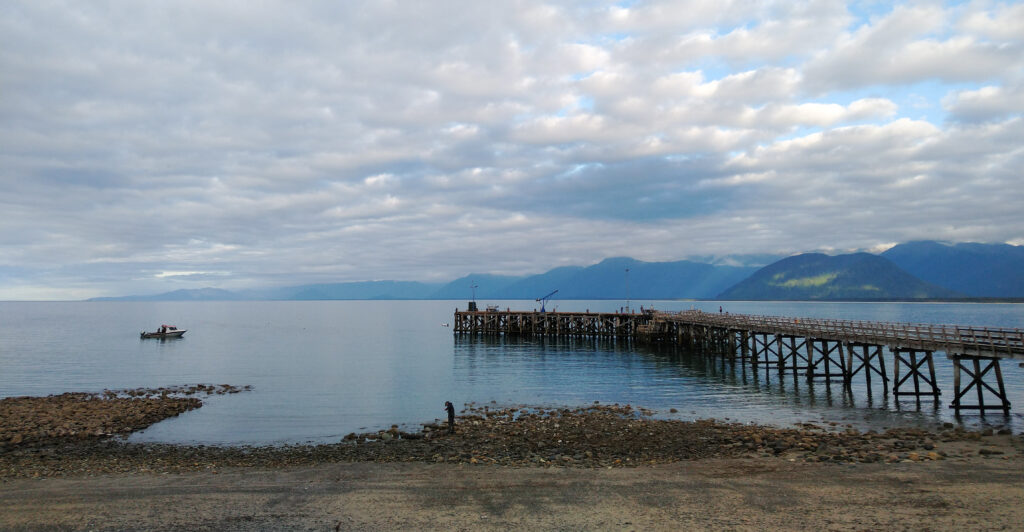
Karamea
Nestled at the northern tip, Karamea is a hidden gem of the West Coast region! This remote township, embraced by lush forests and bordered by the wild Tasman Sea, offers a unique blend of untouched beauty, outdoor adventures, and a laid-back atmosphere. Karamea serves as the gateway to the Kahurangi National Park, where travelers can embark on unforgettable hiking trails, witness stunning limestone formations at Oparara Basin, and explore ancient underground caves. With its pristine beaches, rugged coastlines, and abundant native wildlife, Karamea is a haven for those seeking a true off-the-beaten-path experience.
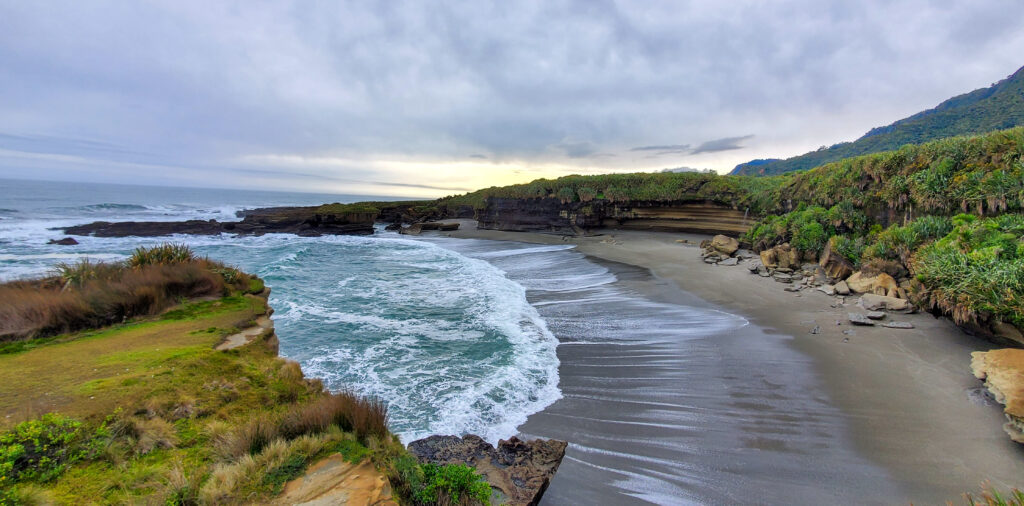
Best Places to Stay on the West Coast
The West Coast offers a range of accommodation options to suit every budget and preference. From boutique hotels, cozy bed and breakfasts, to camping along this magnificent stretch of coastline, there’s something for every kind of adventure seeker! For a unique experience, consider staying in a remote beachfront lodge or a secluded cabin nestled in the rainforest.
Budget-friendly accommodation options on the West Coast
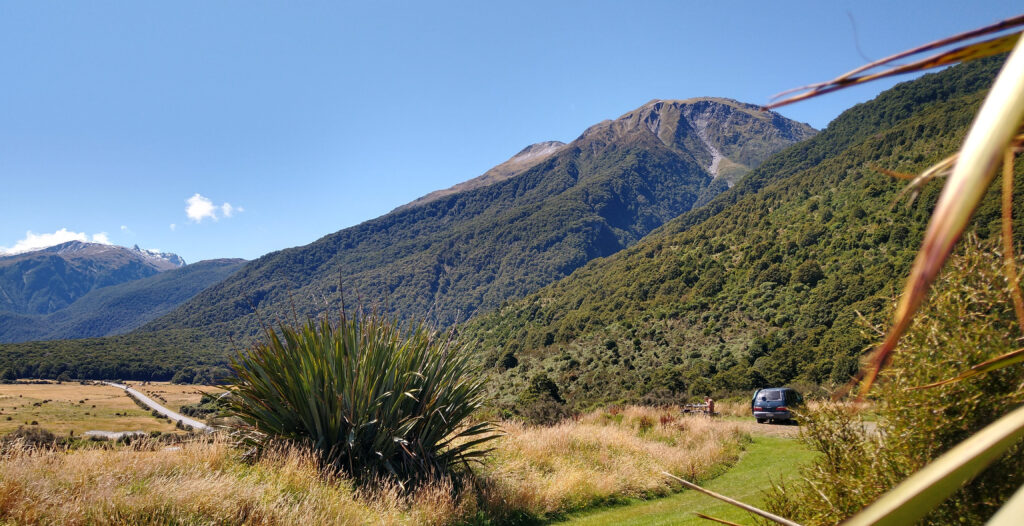
1. Ivory Tower Backpackers | Fox Glacier
Ivory Towers is a fantastic place to stay while exploring the area around the magnificent Fox Glacier. It offers both private and dorm rooms for a good price, as well as awesome kitchens and washroom facilities, laundry, and even a sauna and hot tub! (much needed after spending the day wandering around the glacier!). Check it out here!
2. Rainforest Retreat Holiday Park | Franz-Josef
This is awesome backpacker accommodation found in Franz-Josef, and is an excellent place to base yourself for a few days of adventure! It offers both private and dorm rooms, with free WIFI, BBQ and kitchen facilities, as well as an awesome sauna and hot tub! It is a short walk out of town, and set amongst the lush native rainforest, and so it feels like a perfect place to soak up some of the amazing New Zealand scenery on a budget… check it out for yourself!
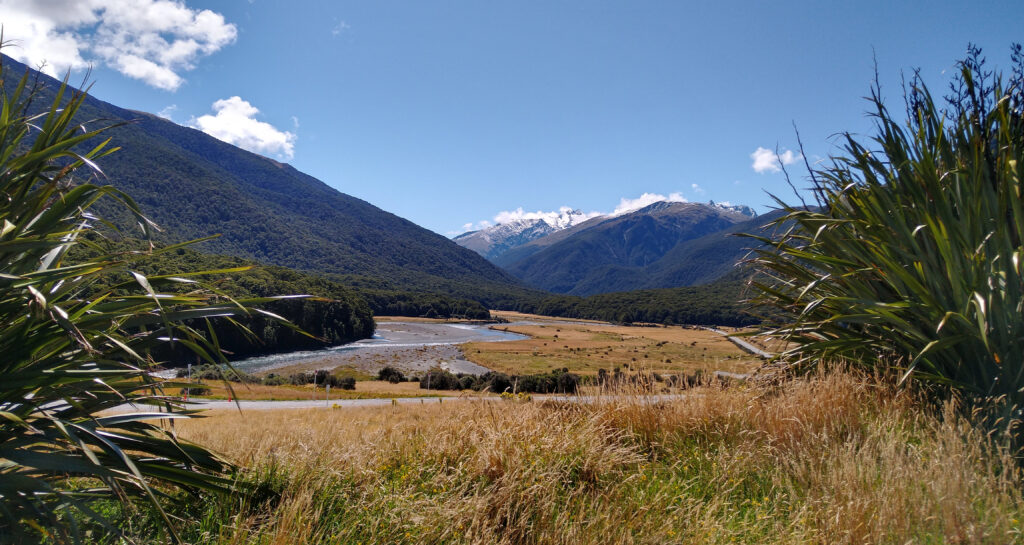
3. Cameron Flat Campground | Haast Pass
This is a very rustic campground run by the Department of Conservation, and we stayed here for one night while visiting the Blue Pools in Haast Pass! It offers great views and lots of space to park up for the night, but is very limited in facilities – with only a small toilet block and sick for washing up.
Make sure to bring bug repellent – the one downside to camping on the West Coast is that you can be eaten alive!
4. Seaview Lodge and Campground | Hokitika
An awesome campground located in the heart of Hokitika, with a variety of budget rooms and camping options for however you like to travel! The campground offers awesome ocean views, fabulous facilities, and (bonus) a short walk to the Glow-Worm Dell only a few minutes away! We ended up staying here for longer than planned, and truly enjoyed our stay!
For more awesome accommodation options in Hokitika, check out my post here!
5. Punakaiki Beach Camp | Punakaiki
Punakaiki Beach Camp is located in a picturesque beachside setting adjoining the Paparoa National Park, just 1km north of the famous Pancake Rocks. It is an excellent base to explore the limestone gorges, bushwalks, beaches, and blowholes in the area!
Facilities include WIFI, hot showers, a laundry and a fully-equipped kitchen, which makes it an awesome place to stay on a budget!
For more awesome accommodations options in Punakaiki, click here! 🙂
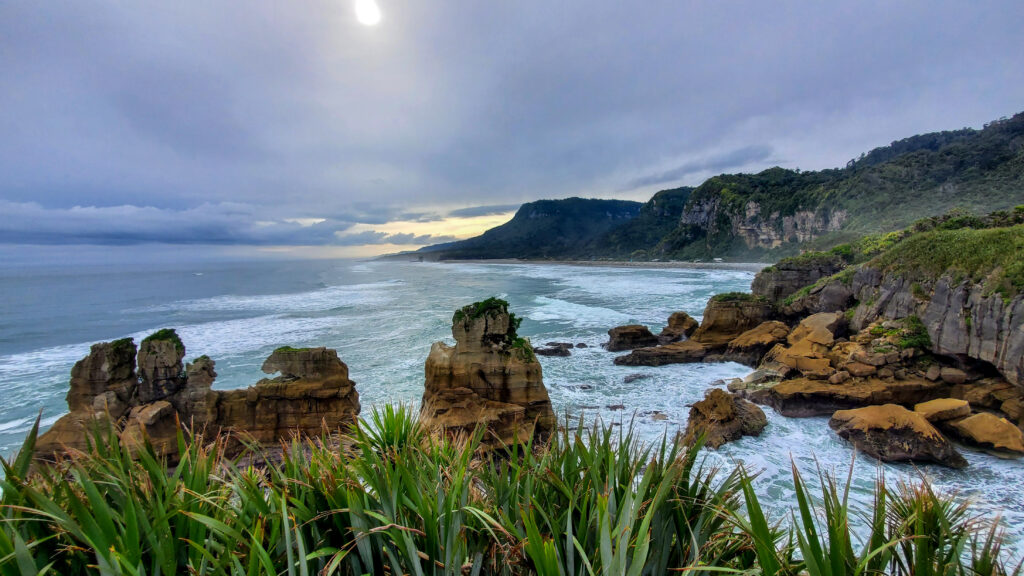
FAQ – Frequently asked Questions about the West Coast of New Zealand!
What is the best way to explore the West Coast of New Zealand?
The best way to explore the West Coast is by car. It allows you to have the flexibility to stop at various attractions and take in the stunning views along the way.
Are there any hiking trails suitable for beginners?
Yes, there are several hiking trails suitable for beginners on the West Coast. The Truman Track and the Hokitika Gorge Track are great options that offer beautiful scenery without being too challenging.
Are there any wildlife encounters on the West Coast?
Absolutely! The West Coast is home to a variety of wildlife. Keep an eye out for seals, dolphins, and even penguins along the coast. You may also spot native birds like the kea or the kiwi.
Is it possible to visit the glaciers without a guided tour?
While it’s possible to visit the glacier areas independently, we highly recommend taking a guided tour. The guides are knowledgeable about the terrain and can ensure your safety during the visit.
Are there any traditional Maori cultural experiences on the West Coast?
Yes, there are opportunities to experience Maori culture on the West Coast. Look for cultural performances, traditional food experiences, and guided tours that offer insights into Maori traditions and history.
What should I pack for a trip to the West Coast?
Pack warm and waterproof clothing, especially if you plan to visit the glaciers or explore the rainforest. Also, don’t forget your hiking boots, insect repellent, and a camera to capture the stunning landscapes.
What is the West Coast of New Zealand Known for?
The West Coast of New Zealand is known for its stunning natural beauty and rugged landscapes. It is particularly renowned for its glaciers, including Franz Josef Glacier and Fox Glacier, which attract visitors from around the world. The region is also famous for its lush rainforests, pristine rivers, and dramatic coastline, making it a paradise for outdoor enthusiasts and nature lovers.
What is the main city on the West Coast of New Zealand?
The main city near the West Coast of New Zealand is Greymouth. It is the largest town on the West Coast and serves as a hub for transportation and commerce in the region.
What is the climate like on the West Coast of New Zealand?
The climate on the West Coast of New Zealand is characterized by high rainfall and a temperate climate. It experiences mild temperatures, with cooler winters and pleasant summers. The high rainfall contributes to the region’s lush rainforests and vibrant green landscapes.
Why is the West Coast of New Zealand so popular?
The West Coast of New Zealand is popular for several reasons. Its natural beauty, including glaciers, rainforests, and rugged coastlines, attracts tourists seeking to experience pristine wilderness. The region’s remote and untouched landscapes offer a sense of adventure and escape from urban life. Additionally, the West Coast’s rich history, including its gold mining heritage and Maori culture, adds to its appeal as a unique and authentic destination.
Thank you for reading my post about travelling the West Coast of New Zealand! I hope it gave you some inspiration in things to do and where to stay while you are enjoying this wild bit of coastline. We thoroughly enjoyed our time here, and I hope you do to! 🙂
If you liked this, please share with your mates, and check out some of my other travel guides to different regions of New Zealand!

